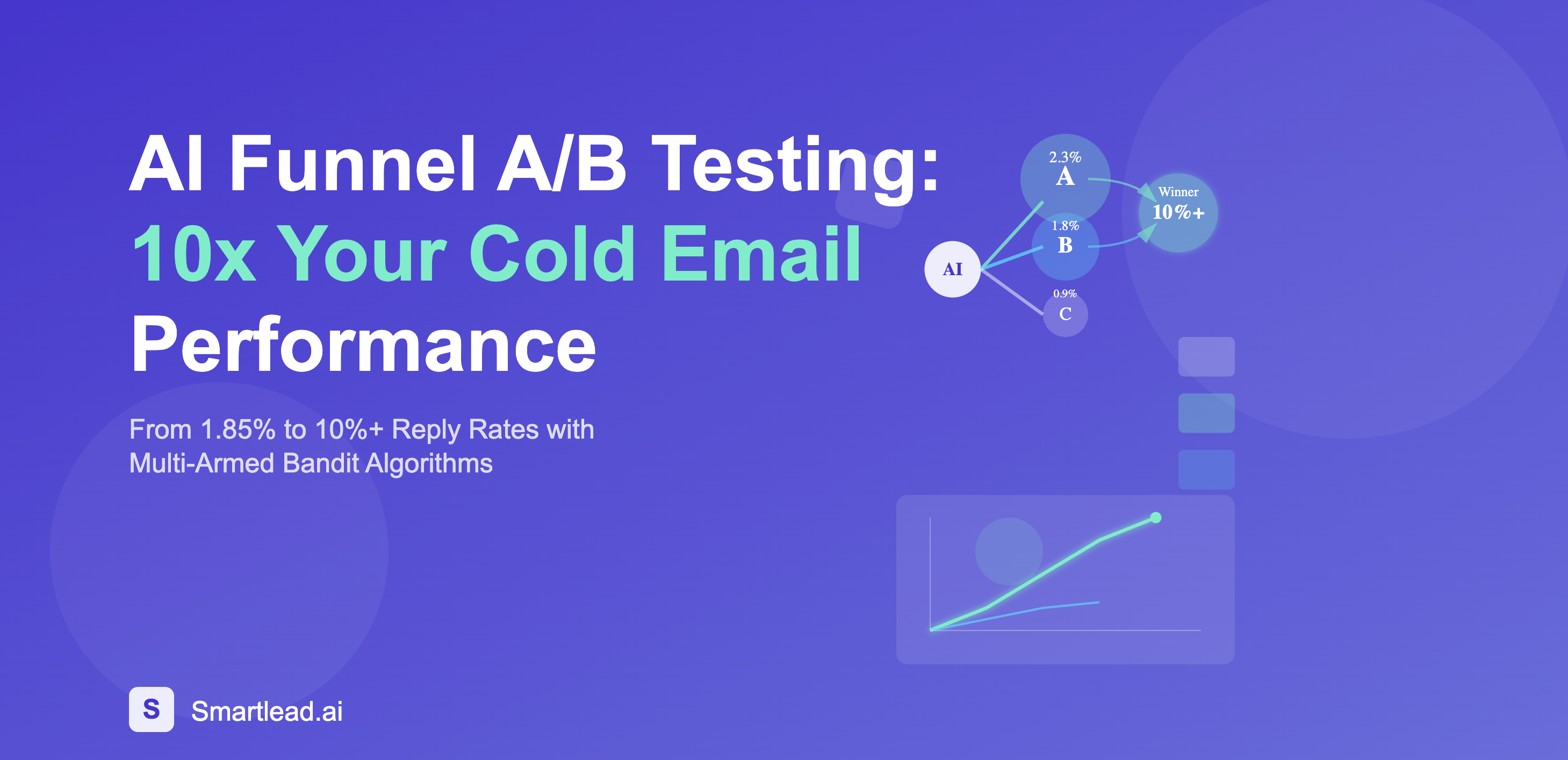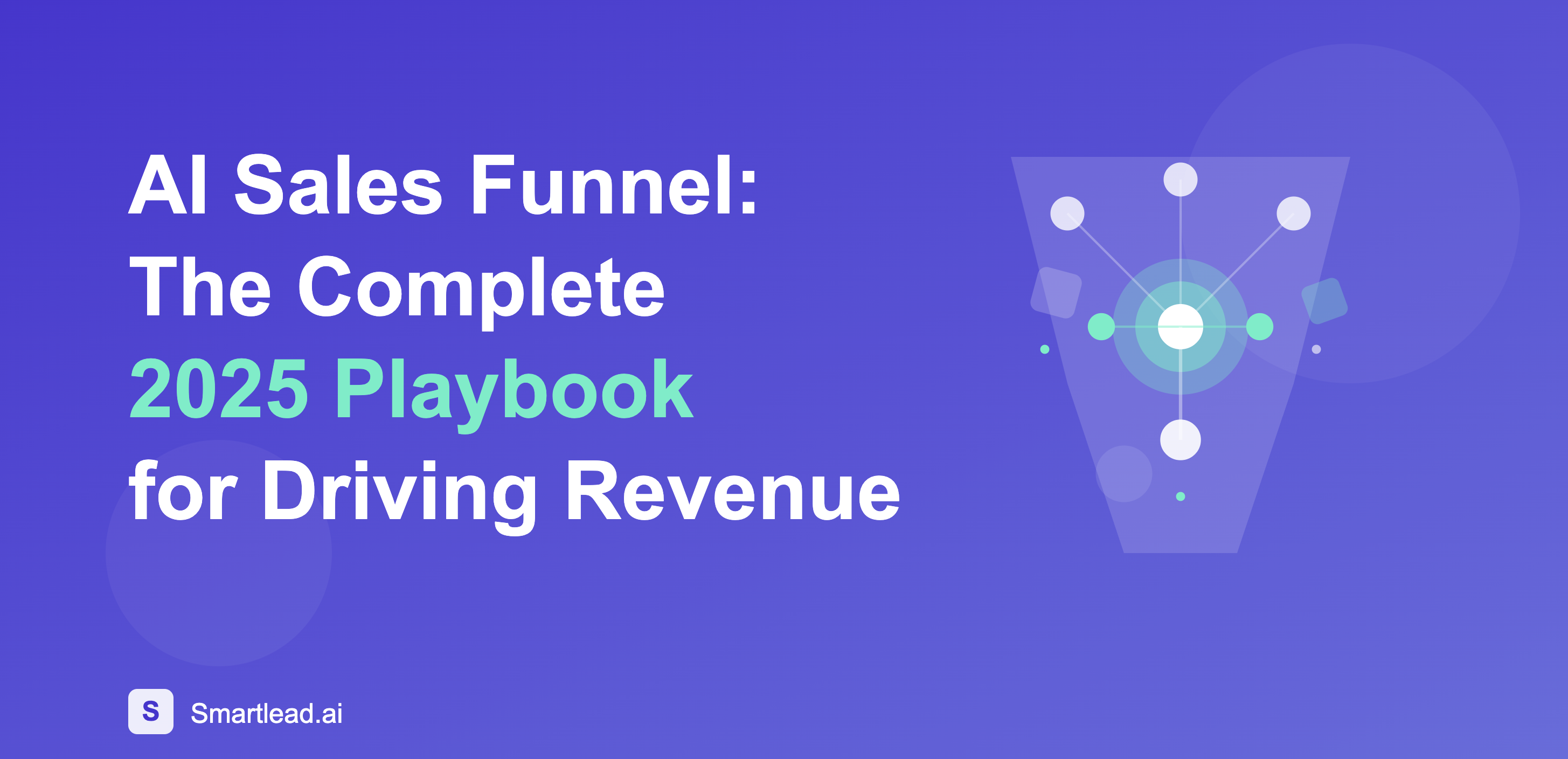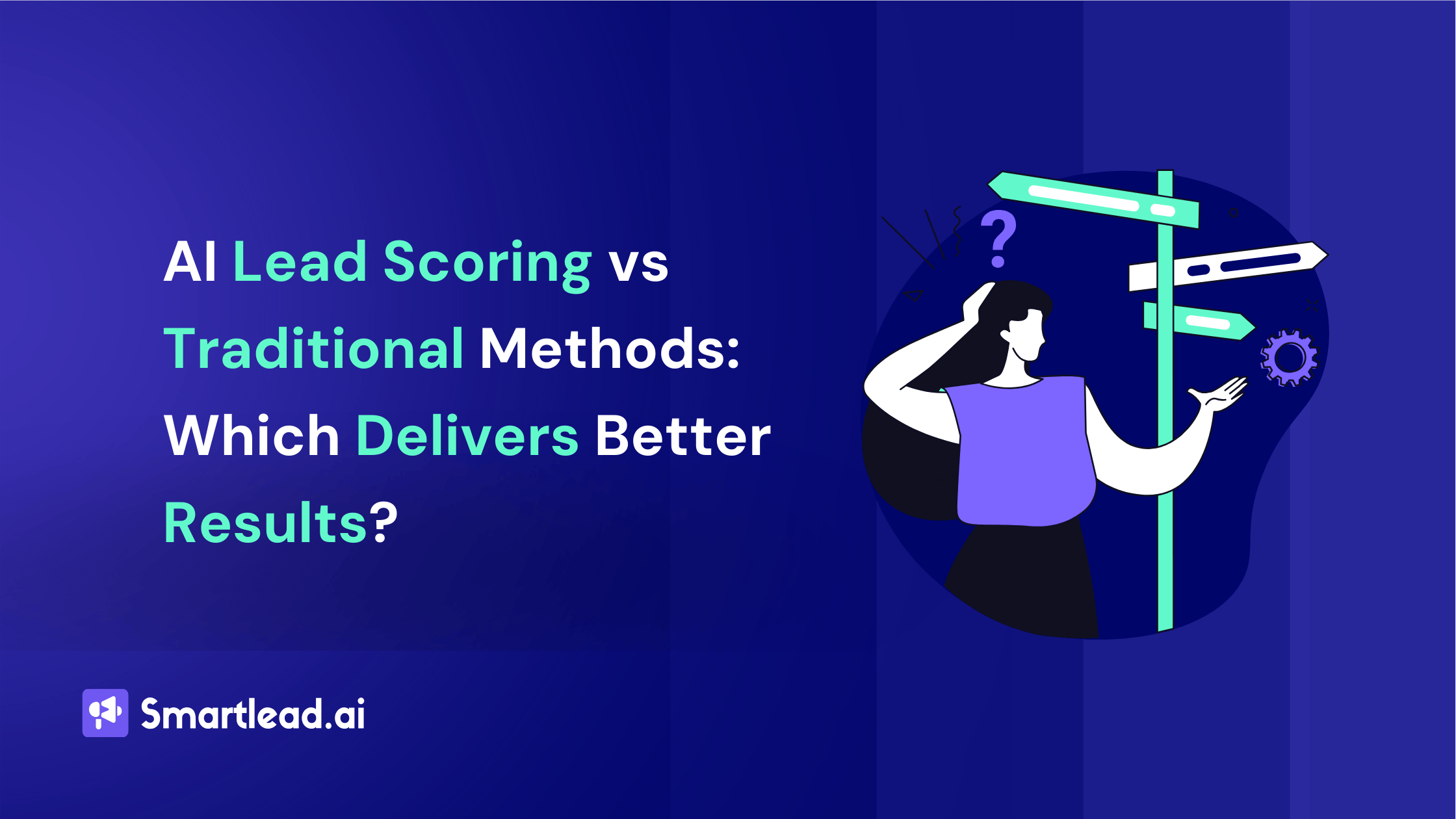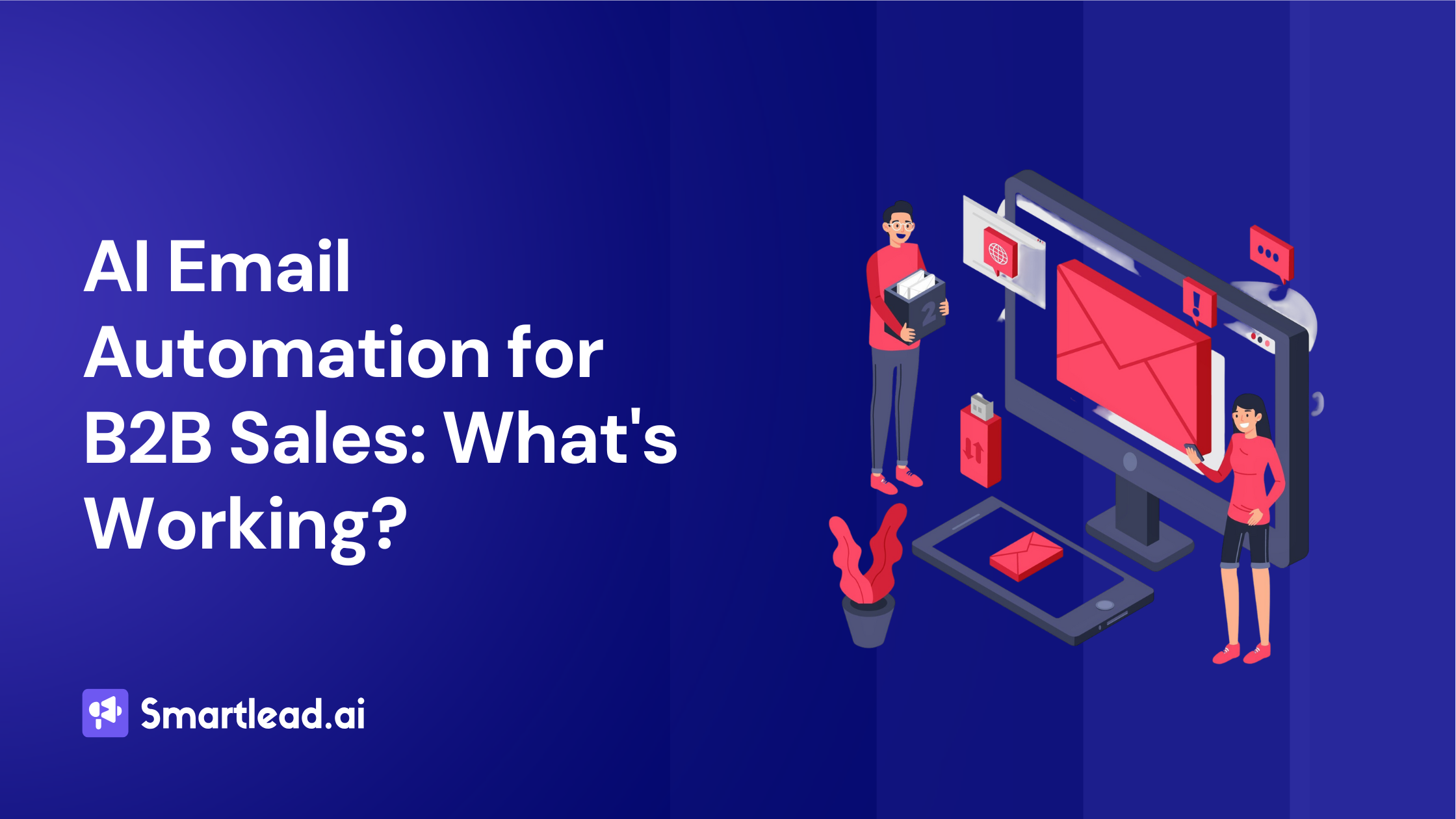AI Funnel A/B Testing: Scale Cold Outreach with Machine Learning

Heading
Every year, B2B companies waste an estimated $47 billion on ineffective outreach. It includes sending millions of emails that generate reply rates below 2%.
The reason? Sales teams are working on manual A/B testing. Traditional funnels move too slowly and offer very little room for optimization at the pace modern sales teams require.
Usually, SDRs follow a painful email testing pattern:
First, you create two variants manually, split traffic 50/50, wait weeks for statistical significance, implement the winner, then start over.
By the time you've optimized one element, market conditions have shifted, your competitors have evolved their messaging, and your prospects' priorities have changed.
AI-powered funnel testing changes this equation entirely.
Instead of testing one subject line over three weeks, imagine simultaneously optimizing subject lines, email copy, personalization depth, send times, and follow-up sequences—all while the system automatically allocates more traffic to winning combinations.
When I say this, I’m not at all talking theoretically but something that we have observed Smartlead users are successfully pulling off.
With the proper infrastructure and approach, B2B teams can run statistically significant tests across multiple variants within 24-48 hours. They can continuously improve their cold outreach performance without manual intervention.
What is AI Funnel A/B Testing for Cold Outreach?
AI funnel A/B testing applies machine learning algorithms to optimize every stage of your cold email funnel. Right from the initial outreach through follow-up sequences you can minutely A/B test every section of your funnel with AI.
Unlike traditional split testing that evaluates isolated elements sequentially, AI-powered testing orchestrates multivariate experiments across your entire outreach infrastructure.
The core innovation lies in dynamic traffic allocation. Multi-armed bandit algorithms continuously adjust which variants receive traffic based on real-time performance data. When a subject line shows promise, the algorithm automatically sends more emails with that variant while maintaining enough exploration to discover potentially superior combinations.
For cold outreach specifically, this means your system can simultaneously test:
- Subject line variations: Question-based vs. value proposition vs. pain point approaches
- Personalization depth: Generic greetings vs. first-name vs. company-specific customization
- Email length: Short 50-word emails vs. detailed 200-word messages
- Send timing: Business hours optimization across time zones
- Follow-up sequences: 2-day vs. 4-day vs. 7-day intervals between touches
The result is a self-optimizing outreach system that improves with every email sent, learning from patterns across thousands of interactions to maximize reply rates.
The Technical Foundation: How AI Algorithms Transform Email A/B Testing
Multi-Armed Bandits vs. Traditional A/B Testing
Traditional A/B testing operates on a rigid explore-then-exploit framework.
You explore by testing variants equally, then exploit by implementing the winner. This creates an opportunity cost.
Because during the testing phase you're sending suboptimal variants to half your prospects.
Multi-armed bandit algorithms solve this through continuous optimization. Using techniques like Thompson Sampling or Upper Confidence Bound, these algorithms balance exploration of new variants with exploitation of proven performers.
Let's have a look at a practical example:
In a typical enterprise setup when testing across 150+ mailboxes a bandit algorithm might initially distribute variants equally across all mailboxes.
As performance data accumulates, lets say Variant A achieves a 2.3% reply rate while Variant B hits 1.8%. The algorithm gradually shifts more mailboxes to Variant A while maintaining enough traffic to Variant B to detect any performance changes.
Statistical Significance at Scale
The mathematics of statistical significance change dramatically when you can test at scale. With traditional testing, reaching 95% confidence might require 1,000+ emails per variant. But when you're testing across multiple mailboxes simultaneously, you can achieve significance faster through:
Pooled Variance Estimation: Combining data across mailboxes reduces variance in your estimates, allowing faster convergence to true performance differences.
Bayesian Inference: Instead of binary "significant/not significant" decisions, Bayesian methods provide probability distributions of variant performance, enabling decision-making with uncertainty quantification.
Sequential Testing: Continuously monitoring results allows early stopping when clear winners emerge, preventing wasted sends on inferior variants.
The Power of Spintax and Dynamic Content
Modern email platforms leverage spintax (spinning syntax) to create multiple variations without campaign duplication. A single template with spintax can generate 30+ unique variations:
{Hi|Hello|Hey} {{first_name}},
{I noticed|I saw|I came across} your {recent post about|work on|insights around} {{topic}}.
{I wanted to reach out because|I'm reaching out as|Quick note:} we've helped {similar companies|businesses like yours|companies in {{industry}}} {achieve|reach|accomplish} {specific outcome}.
{Would you be open to|Interested in|Can we explore} a {quick chat|brief discussion|15-minute call}?
This single template can generate dozens of unique emails, each tracked separately for performance analysis. AI algorithms learn which combinations resonate with different segments, automatically optimizing the selection process.
How to Build Your AI Funnel A/B Testing Infrastructure?

Essential Components for Scale
To implement AI funnel A/B testing effectively, you need infrastructure capable of handling multiple variants simultaneously while maintaining deliverability.
Here's what a robust testing setup requires:
1. Multi-Mailbox Architecture
- Minimum viable setup: 20-30 mailboxes for basic A/B testing
- Optimal configuration: 100+ mailboxes for true multivariate testing
- Enterprise scale: 150+ mailboxes enabling 5+ simultaneous variants
Each mailbox group tests different variants, with the AI algorithm dynamically adjusting allocation based on performance. With 156 mailboxes, you can run 3-5 subject line variants simultaneously, each with sufficient volume for statistical significance.
2. Real-Time Performance Tracking Your infrastructure must capture and process metrics in real-time:
- Open rates (with tracking pixel reliability considerations)
- Reply rates (the gold standard metric for cold outreach)
- Bounce rates (critical for deliverability management)
- Response sentiment (positive, negative, neutral categorization)
Automated categorization using AI eliminates manual sorting of responses, enabling rapid iteration cycles.
3. Dynamic Content Generation Implement systems supporting:
- Spintax with 30+ variations per template
- Conditional logic based on prospect attributes
- Dynamic personalization tokens ({{first_name}}, {{company}}, custom variables)
- Multi-language support for global campaigns
4. Statistical Computing Layer The AI optimization engine requires:
- Real-time data ingestion from all mailboxes
- Bandit algorithm implementation (Thompson Sampling recommended for email)
- Confidence interval calculation for decision-making
- Automated winner selection and traffic reallocation
Implementation Roadmap
Phase 1: Baseline Establishment (Days 1-7) Start by documenting current performance metrics. If your baseline reply rate is 1.85% (industry average for cold email), this becomes your optimization target.
Track:
- Overall reply rate
- Reply rate by mailbox
- Bounce and spam rates
- Time-to-reply distribution
Phase 2: Simple A/B Testing (Days 8-14) Before implementing full AI optimization, run controlled A/B tests to validate your infrastructure:
- Test 2-3 subject line variants
- Maintain 50/50 traffic split
- Verify tracking accuracy
- Confirm statistical significance calculations
Phase 3: Multi-Variant Testing (Days 15-21) Expand to testing 3-5 variants simultaneously:
- Subject lines + preview text combinations
- Different personalization depths
- Varying email lengths
- Multiple CTA positions
Monitor infrastructure stability and mailbox rotation effectiveness.
Phase 4: AI Algorithm Implementation (Days 22-30) Deploy bandit algorithms for dynamic optimization:
- Start with epsilon-greedy (ε=0.1) for simplicity
- Monitor exploitation vs. exploration balance
- Implement automated winner selection
- Enable continuous learning mode
Phase 5: Full Funnel Orchestration (Days 31+) Extend AI optimization across the entire outreach sequence:
- Initial email optimization
- Follow-up timing and messaging
- Multi-touch attribution modeling
- Segment-specific personalization
Advanced Optimization Strategies for Cold Outreach
Contextual Bandits for Segment Personalization
Not all prospects respond equally to the same messaging. Contextual bandit algorithms learn which variants perform best for specific segments without explicit programming.
Segmentation Variables for B2B Outreach:
- Company size: Enterprise vs. SMB messaging tone
- Industry vertical: Technical depth for software vs. simplicity for retail
- Job title: Executive brevity vs. practitioner detail
- Geography: Time zone and cultural considerations
- Engagement history: Previous email opens or website visits
The algorithm automatically discovers patterns. Perhaps CTOs prefer technical specificity while CEOs respond to business outcomes. The system learns these preferences and adapts accordingly.
Sequential Optimization Across Follow-Ups
Email sequences present unique optimization challenges. The performance of Follow-up 3 depends on the content of Emails 1 and 2. AI algorithms can optimize these dependencies through:
Markov Chain Modeling: Treating the email sequence as a Markov process where each email's success probability depends on the previous interaction.
Reinforcement Learning: Optimizing for long-term conversion rather than immediate reply, learning which early messages set up successful later conversions.
Practical Implementation:
- Email 1: Test value proposition clarity (3 variants)
- Email 2: Test social proof vs. case study vs. direct ask
- Email 3: Test urgency vs. additional value vs. breakup email
- AI optimizes the complete path, not individual emails
Time-Based Optimization Patterns
Sending time significantly impacts cold email performance, but optimal timing varies by segment and geography. AI algorithms can discover complex temporal patterns:
Multi-Level Time Optimization:
- Hour of day: 8-10 am vs. 12-2 pm vs. 4-6 pm local time
- Day of week: Monday momentum vs. Thursday planning vs. Friday cleanup
- Week of month: Beginning-of-month budgets vs. end-of-month urgency
- Seasonal patterns: Q4 budget cycles vs. summer slowdowns
With sufficient data, AI identifies non-obvious patterns like "Directors in FinTech respond best to Tuesday 2pm emails, while Healthcare VPs prefer Thursday mornings."
Measuring Success: KPIs and Statistical Rigor
Primary Metrics for Cold Outreach Optimization
Reply Rate: The north star metric for cold email
- Baseline: 1.85% (industry average)
- Good: 3-4% (with basic optimization)
- Excellent: 5-7% (with AI optimization and quality targeting)
- Elite: 10%+ (highly targeted, fully optimized campaigns)
Positive Reply Rate: Separating interest from rejections
- Track using AI sentiment analysis
- Typical ratio: 30-40% of replies are positive
- Optimization goal: Increase both total and positive reply rates
Email-to-Meeting Rate: The ultimate conversion metric
- Baseline: 0.5-1% of emails generate meetings
- Target: 2-3% with optimized sequences
- Calculation: Meetings booked ÷ Total emails sent
Deliverability Metrics: Protecting sender reputation
- Bounce rate: Maintain below 1%
- Spam rate: Keep under 0.1%
- Inbox placement rate: Target 95%+
Statistical Significance in Dynamic Testing
Traditional significance testing assumes fixed sample sizes and equal allocation. AI-powered testing requires adjusted statistical methods:
Adaptive Stopping Rules: Using sequential probability ratio tests (SPRT) to determine when enough evidence exists to declare a winner without waiting for predetermined sample sizes.
False Discovery Rate Control: When testing multiple variants simultaneously, adjust for multiple comparisons using Benjamini-Hochberg procedures to limit false positives.
Confidence Intervals for Bandit Algorithms: Rather than point estimates, report credible intervals that account for the adaptive allocation:
- "Variant A achieves 2.3-2.7% reply rate with 95% probability"
- "Variant B underperforms by 15-25% relative to Variant A"
Attribution and Long-Term Impact
Cold email success isn't just about immediate replies. Track long-term impact through:
Multi-Touch Attribution:
- First-touch attribution: Which initial email generated awareness
- Last-touch attribution: Which message triggered the reply
- Data-driven attribution: ML models determining each touchpoint's contribution
Cohort Analysis:
- Track reply rates over time for each optimization period
- Measure quality degradation (do optimized emails maintain performance?)
- Monitor list fatigue and segment exhaustion
Revenue Attribution:
- Connect email replies to pipeline generation
- Calculate revenue per email sent
- Determine customer acquisition cost (CAC) impact
Real-World Implementation: A Practical Framework
Week 1: Infrastructure Audit and Baseline
Before implementing AI optimization, ensure your infrastructure can handle the complexity:
Technical Checklist:
- Minimum 20 mailboxes configured and warmed
- Tracking pixels and reply detection functioning
- Spintax engine supporting 10+ variations
- Real-time dashboard for performance monitoring
- Automated bounce and reply handling
Baseline Metrics to Document:
- Current reply rate across all campaigns
- Reply rate variance between mailboxes
- Average time to reply
- Bounce and complaint rates
- Infrastructure uptime (target: 97%+)
Week 2: Initial A/B Testing
Start with simple A/B tests to validate your testing framework:
Test 1: Subject Line Length
- Variant A: Short (3-5 words) - "Quick question {{first_name}}"
- Variant B: Medium (7-9 words) - "Saw your post about {{topic}} - quick thought"
- Variant C: Long (10-12 words) - "How {{company}} can reduce costs by 30% in Q1"
Send 500 emails per variant, measure reply rates.
Test 2: Personalization Depth
- Variant A: No personalization - "Hello"
- Variant B: Name only - "Hi {{first_name}}"
- Variant C: Full context - "Hi {{first_name}}, saw your {{recent_achievement}}"
Test 3: Opening Line Approach
- Variant A: Direct value - "I can help you achieve X"
- Variant B: Question-based - "Are you struggling with Y?"
- Variant C: Social proof - "We've helped 50 companies like yours"
Week 3: Multivariate Expansion
Combine winning elements and test interactions:
Combined Test Matrix:
- Subject line winner + Personalization variants
- Best opening + Different CTAs
- Optimal length + Send time testing
Infrastructure Scaling:
- Increase to 50+ mailboxes active
- Implement automated variant allocation
- Deploy preliminary bandit algorithm (epsilon-greedy)
- Monitor system stability under load
Week 4: AI Algorithm Deployment
Transition from manual to algorithmic optimization:
Algorithm Configuration:
- Thompson Sampling for subject line optimization
- Contextual bandits for segment personalization
- Reinforcement learning for sequence optimization
Performance Monitoring:
- Real-time variant performance tracking
- Automated significance testing
- Winner declaration and traffic reallocation
- Continuous learning activation
Week 5+: Continuous Optimization
Establish ongoing optimization workflows:
Daily Operations:
- Monitor algorithm decisions
- Review winner selections
- Investigate underperforming segments
- Adjust exploration parameters
Weekly Reviews:
- Analyze overall performance trends
- Identify new testing opportunities
- Refine segment definitions
- Update personalization tokens
Monthly Strategic Updates:
- Comprehensive performance analysis
- Algorithm parameter tuning
- Infrastructure scaling decisions
- ROI calculation and reporting
Common Pitfalls and How to Avoid Them
Pitfall 1: Over-Optimization for Replies
Problem: AI optimizes for reply rate without considering reply quality, generating more responses but fewer qualified leads.
Solution:
- Implement sentiment analysis to categorize positive vs. negative replies
- Weight positive replies higher in optimization calculations
- Track email-to-meeting conversion as a guardrail metric
- Regularly audit reply quality manually
Pitfall 2: Segment Contamination
Problem: The same prospect receives different variants through multiple mailboxes, confusing message consistency.
Solution:
- Implement strict deduplication before campaign launch
- Use deterministic hashing to ensure consistent variant assignment
- Maintain a central prospect database across all mailboxes
- Track cross-mailbox interactions
Pitfall 3: Statistical False Positives
Problem: With multiple variants testing simultaneously, random variations appear significant.
Solution:
- Apply Bonferroni correction for multiple comparisons
- Require larger effect sizes for significance (>20% improvement)
- Run confirmation tests on winning variants
- Implement holdout groups for validation
Pitfall 4: Infrastructure Degradation
Problem: Aggressive testing damages sender reputation, reducing overall deliverability.
Solution:
- Maintain strict bounce rate thresholds (<1%)
- Implement gradual volume ramping
- Monitor mailbox health scores continuously
- Reserve 20% of mailboxes for stable, proven variants
Pitfall 5: Algorithm Drift
Problem: AI algorithms optimize for short-term metrics while long-term performance degrades.
Solution:
- Implement exploration bonuses to prevent premature convergence
- Regularly reset algorithm learning (monthly recommended)
- Maintain manual override capabilities
- Track long-term cohort performance
The ROI of AI-Powered Email Testing
Quantifying Financial Impact
Let's model the ROI for a typical B2B SaaS company:
Baseline Scenario:
- Monthly email volume: 10,000
- Current reply rate: 1.85%
- Positive reply rate: 35% of replies
- Email-to-meeting rate: 0.5%
- Meeting-to-opportunity rate: 20%
- Average deal size: $30,000
- Close rate: 25%
Monthly baseline revenue attribution:
- Meetings generated: 50
- Opportunities created: 10
- Deals closed: 2.5
- Revenue: $75,000
With AI Optimization (Conservative 50% improvement):
- New reply rate: 2.78%
- Email-to-meeting rate: 0.75%
- Meetings generated: 75
- Opportunities created: 15
- Deals closed: 3.75
- Revenue: $112,500
Monthly revenue increase: $37,500 Annual revenue impact: $450,000
Cost-Benefit Analysis
Investment Required:
- Additional mailbox infrastructure: $2,000/month
- AI optimization platform: $3,000/month
- Setup and training: $10,000 one-time
- Ongoing optimization management: $2,000/month
- Total monthly cost: $7,000
ROI Calculation:
- Monthly benefit: $37,500
- Monthly cost: $7,000
- Net monthly gain: $30,500
- ROI: 436%
- Payback period: < 1 month
Beyond Direct Revenue
AI optimization generates compound benefits:
Sales Team Efficiency:
- Higher quality leads reduce time spent on unqualified prospects
- Better reply rates improve SDR morale and retention
- Automated testing frees up time for relationship building
Market Intelligence:
- Discover which messages resonate with different segments
- Identify emerging pain points through reply analysis
- Test new value propositions quickly and cheaply
Competitive Advantage:
- Faster testing velocity than manual competitors
- Continuously improving performance while others remain static
- Building proprietary data on what works in your market
How to Future-Proof Your Cold Outreach Strategy with AI Funnels?
Emerging Technologies
Large Language Models for Variant Generation: AI can now generate entire email variants based on performance data. Instead of manually writing spintax, describe your goal and let AI create dozens of contextually appropriate variants.
Predictive Send Time Optimization: Machine learning models that predict optimal send times based on:
- Historical engagement patterns
- Real-time email activity
- Calendar integration for meeting availability
- Industry-specific behavioral patterns
Hyper-Personalization at Scale: Combining multiple data sources for deep personalization:
- LinkedIn activity analysis
- Company news and triggers
- Technology stack detection
- Buyer intent signals
Preparing for Privacy Changes
Email tracking faces increasing restrictions. Prepare by:
Diversifying Success Metrics:
- Focus on reply rates over open rates
- Implement link tracking alternatives
- Develop response quality scoring
- Track downstream conversion metrics
Building First-Party Data Assets:
- Create valuable content for email collection
- Implement progressive profiling
- Build behavioral scoring models
- Develop proprietary intent signals
The Next Frontier: Conversational AI
The future of cold outreach isn't just optimized first emails—it's AI-powered conversation management:
Automated Response Handling:
- AI categorizes and routes responses
- Suggested follow-ups based on reply content
- Automated booking for positive responses
- Intelligent objection handling suggestions
Dynamic Conversation Flows:
- AI adjusts messaging based on prospect responses
- Real-time sentiment analysis guides tone
- Automatic escalation to human reps when needed
- Learning from successful conversation patterns
Conclusion
The gap between companies using AI-powered testing and those relying on manual optimization will only widen. While your competitors test one subject line per month, AI-powered systems test dozens of variants daily, continuously improving performance.
With proper infrastructure, whether 150+ mailboxes or just 20, you can implement AI optimization to deliver measurable results within 30 days. The question isn't whether to adopt AI testing, but how quickly you can implement it before your competitors do.
Start with simple A/B tests to establish baselines. Scale to multivariate testing as you build confidence. Deploy AI algorithms when you're ready for exponential improvement. The path is clear, the tools are available, and the ROI is undeniable.
Author’s Details

Edited by:
Lorem ipsum dolor sit amet, consectetur adipiscing elit. Suspendisse varius enim in eros elementum tristique. Duis cursus, mi quis viverra ornare, eros dolor interdum nulla, ut commodo diam libero vitae erat. Aenean faucibus nibh et justo cursus id rutrum lorem imperdiet. Nunc ut sem vitae risus tristique posuere.
People will also read

AI Sales Funnel: The Complete Playbook for 2025

AI Lead Scoring vs Traditional Methods: Which Delivers Better Results?
Frequently asked questions
What is Smartlead's cold email outreach software?

Smartlead's cold email outreach tool helps businesses scale their outreach efforts seamlessly. With unlimited mailboxes, fully automated email warmup functionality, a multi-channel infrastructure, and a user-friendly unibox, it empowers users to manage their entire revenue cycle in one place. Whether you're looking to streamline cold email campaigns with automated email warmups, personalization fields, automated mailbox rotation, easy integrations, and spintax, improve productivity, or enhance scalability with subsequences based on lead’s intentions, automated replies, and full white-label experience, our cold email tool implifies it in a single solution.
What is Smartlead, and how can it enhance my cold email campaigns?

Smartlead is a robust cold emailing software designed to transform cold emails into reliable revenue streams. Trusted by over 31,000 businesses, Smartlead excels in email deliverability, lead generation, cold email automation, and sales outreach. A unified master inbox streamlines communication management, while built-in email verification reduces bounce rates.
Additionally, Smartlead offers essential tools such as CNAME, SPF Checker, DMARC Checker, Email Verifier, Blacklist Check Tool, and Email Bounce Rate Calculator for optimizing email performance.
How does Smartlead's unlimited mailboxes feature benefit me?

Our "unlimited mailboxes" feature allows you to expand your email communications without restrictions imposed by a mailbox limit. This means you won't be constrained by artificial caps on the number of mailboxes you can connect and use. This feature makes Smartlead the best cold email software and empowers you to reach a wider audience, engage with more potential customers, and manage diverse email campaigns effectively.
How does Smartlead, as a cold emailing tool, automate the cold email process?

Smartlead’s robust cold email API and automation infrastructure streamline outbound communication by transforming the campaign creation and management processes. It seamlessly integrates data across software systems using APIs and webhooks, adjusts settings, and leverages AI for personalised content.
The cold emailing tool categorises lead intent, offers comprehensive email management with automated notifications, and integrates smoothly with CRMs like Zapier, Make, N8N, HubSpot, Salesforce, and Pipedrive. Smartlead supports scalable outreach by rapidly adding mailboxes and drip-feeding leads into active campaigns Sign Up Now!
What do you mean by "unibox to handle your entire revenue cycle"?

The "unibox" is one of the unique features of Smartlead cold email outreach tool, and it's a game-changer when it comes to managing your revenue cycle. The master inbox or the unibox consolidates all your outreach channels, responses, sales follow-ups, and conversions into one centralized, user-friendly mailbox.
With the "unibox," you gain the ability to:
1. Focus on closing deals: You can now say goodbye to the hassle of logging into multiple mailboxes to search for replies. The "unibox" streamlines your sales communication, allowing you to focus on what matters most—closing deals.
2. Centralized lead management: All your leads are managed from one central location, simplifying lead tracking and response management. This ensures you take advantage of every opportunity and efficiently engage with your prospects.
3. Maintain context: The "unibox" provides a 360-degree view of all your customer messages, allowing you to maintain context and deliver more personalized and effective responses.
How does Smartlead ensure my emails don't land in the spam folder?

Smartlead, the best cold email marketing tool, ensures your emails reach the intended recipients' primary inbox rather than the spam folder.
Here's how it works:
1. Our "unlimited warmups" feature is designed to build and maintain a healthy sending reputation for your cold email outreach. Instead of sending a large volume of emails all at once, which can trigger spam filters, we gradually ramp up your sending volume. This gradual approach, combined with positive email interactions, helps boost your email deliverability rates.
2. We deploy high-deliverability IP servers specific to each campaign.
3. The ‘Warmup’ feature replicates humanized email sending patterns, spintax, and smart replies.
4. By establishing a positive sender reputation and gradually increasing the number of sent emails, Smartlead minimizes the risk of your emails being flagged as spam. This way, you can be confident that your messages will consistently land in the primary inbox, increasing the likelihood of engagement and successful communication with your recipients.
Can Smartlead help improve my email deliverability rates?

Yes, our cold emailing software is designed to significantly improve your email deliverability rates. It enhances email deliverability through AI-powered email warmups across providers, unique IP rotating for each campaign, and dynamic ESP matching.
Real-time AI learning refines strategies based on performance, optimizing deliverability without manual adjustments. Smartlead's advanced features and strategies are designed to improve email deliverability rates, making it a robust choice for enhancing cold email campaign success.
What features does Smartlead offer for cold email personalisation?

Smartlead enhances cold email personalisation through advanced AI-driven capabilities and strategic integrations. Partnered with Clay, The cold remaining software facilitates efficient lead list building, enrichment from over 50 data providers, and real-time scraping for precise targeting. Hyper-personalised cold emails crafted in Clay seamlessly integrate with Smartlead campaigns.
Moreover, Smartlead employs humanised, natural email interactions and smart replies to boost engagement and response rates. Additionally, the SmartAI Bot creates persona-specific, high-converting sales copy. Also you can create persona-specific, high-converting sales copy using SmartAI Bot. You can train the AI bot to achieve 100% categorisation accuracy, optimising engagement and conversion rates.
Can I integrate Smartlead with other tools I'm using?

Certainly, Smartlead cold email tool is designed for seamless integration with a wide range of tools and platforms. Smartlead offers integration with HubSpot, Salesforce, Pipedrive, Clay, Listkit, and more. You can leverage webhooks and APIs to integrate the tools you use. Try Now!

Is Smartlead suitable for both small businesses and large enterprises?
Smartlead accommodates both small businesses and large enterprises with flexible pricing and comprehensive features. The Basic Plan at $39/month suits small businesses and solopreneurs, offering 2000 active leads and 6000 monthly emails, alongside essential tools like unlimited email warm-up and detailed analytics.
Marketers and growing businesses benefit from the Pro Plan ($94/month), with 30000 active leads and 150000 monthly emails, plus a custom CRM and active support. Lead generation agencies and large enterprises can opt for the Custom Plan ($174/month), providing up to 12 million active lead credits and 60 million emails, with advanced CRM integration and customisation options.

What type of businesses sees the most success with Smartlead?
No, there are no limitations on the number of channels you can utilize with Smartlead. Our cold email tool offers a multi-channel infrastructure designed to be limitless, allowing you to reach potential customers through multiple avenues without constraints.
This flexibility empowers you to diversify your cold email outreach efforts, connect with your audience through various communication channels, and increase your chances of conversion. Whether email, social media, SMS, or other communication methods, Smartlead's multi-channel capabilities ensure you can choose the channels that best align with your outreach strategy and business goals. This way, you can engage with your prospects effectively and maximize the impact of your email outreach.

How can Smartlead integrate with my existing CRM and other tools?
Smartlead is the cold emailing tool that facilitates seamless integration with existing CRM systems and other tools through robust webhook and API infrastructure. This setup ensures real-time data synchronisation and automated processes without manual intervention. Integration platforms like Zapier, Make, and N8N enable effortless data exchange between Smartlead and various applications, supporting tasks such as lead information syncing and campaign status updates. Additionally, it offers native integrations with major CRM platforms like HubSpot, Salesforce, and Pipedrive, enhancing overall lead management capabilities and workflow efficiency. Try Now!

Do you provide me with lead sources?
No. Smartlead distinguishes itself from other cold email outreach software by focusing on limitless scalability and seamless integration. While many similar tools restrict your outreach capabilities, Smartlead offers a different approach.
Here's what makes us uniquely the best cold email software:
1. Unlimited Mailboxes: In contrast to platforms that limit mailbox usage, Smartlead provides unlimited mailboxes. This means you can expand your outreach without any arbitrary constraints.
2. Unique IP Servers: Smartlead offers unique IP servers for every campaign it sends out.
3. Sender Reputation Protection: Smartlead protects your sender reputation by auto-moving emails from spam folders to the primary inbox. This tool uses unique identifiers to cloak all warmup emails from being recognized by automation parsers.
4. Automated Warmup: Smartlead’s warmup functionality enhances your sender reputation and improves email deliverability by maintaining humanised email sending patterns and ramping up the sending volume.

How secure is my data with Smartlead?
Ensuring the security of your data is Smartlead's utmost priority. We implement robust encryption methods and stringent security measures to guarantee the continuous protection of your information. Your data's safety is paramount to us, and we are always dedicated to upholding the highest standards of security.
How can I get started with Smartlead?

Getting started with Smartlead is straightforward! Just head over to our sign-up page and follow our easy step-by-step guide. If you ever have any questions or need assistance, our round-the-clock support team is ready to help, standing by to provide you with any assistance you may require. Sign Up Now!
How can I reach the Smartlead team?

We're here to assist you! You can easily get in touch with our dedicated support team on chat. We strive to provide a response within 24 hours to address any inquiries or concerns you may have. You can also reach out to us at support@smartlead.ai






